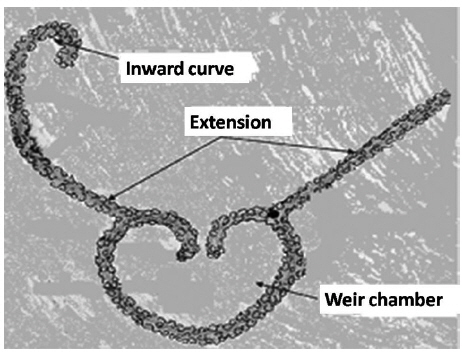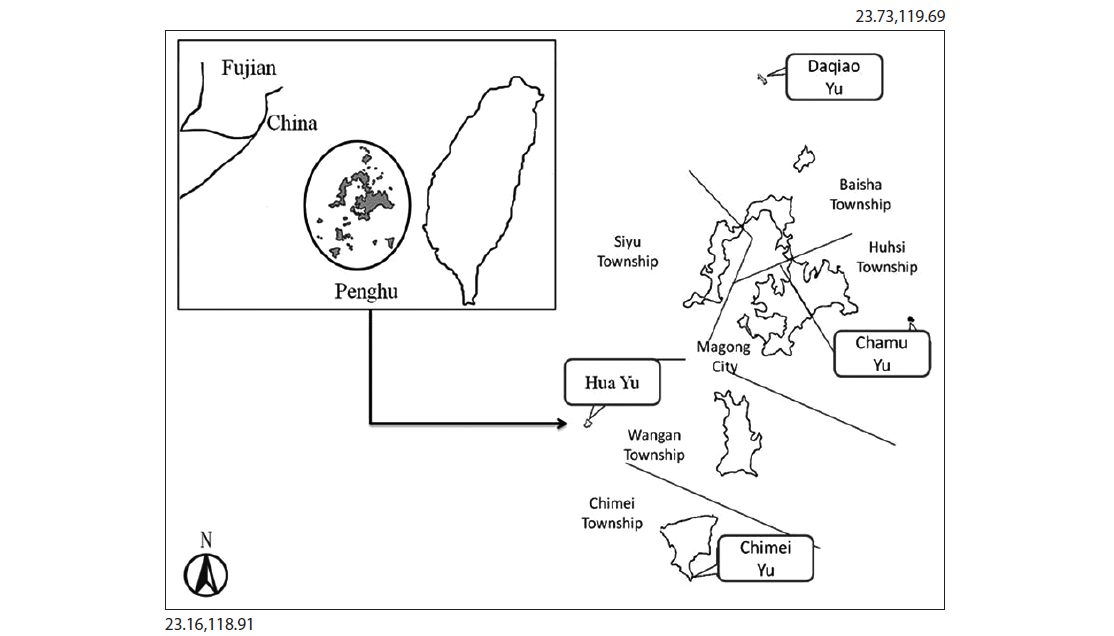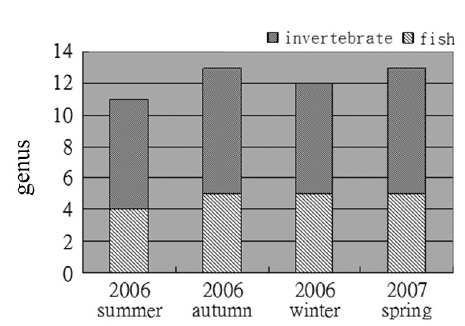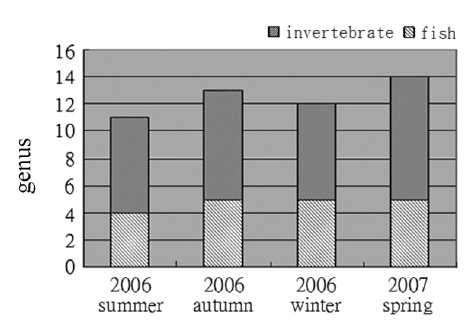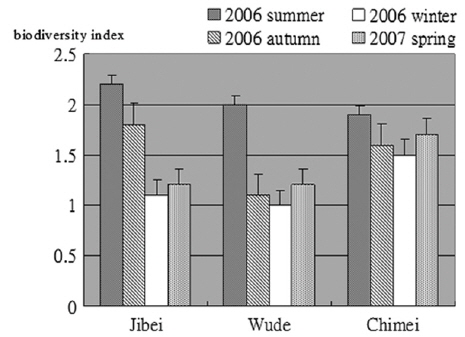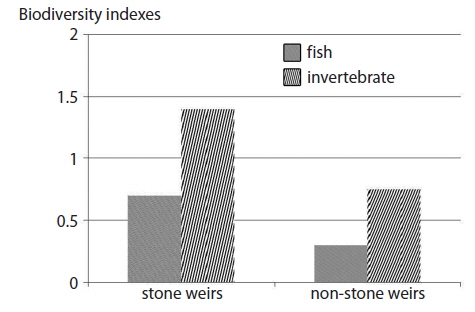



The coastline of Penghu Islands is 448 km long, where ancient fishing activities were undertaken using stone fish weir, beach seine and baulk net, and the fish catches of the stone fish weir were the most abundant. Therefore, the stone fish weirs have been very important for fishermen in Penghu (Lin 2005). Today the stone fish weirs are considered the representative figure of the fishery culture in Penghu, with the highest volumes of fishing in Taiwan. They are historical heritages that provide us a better understanding of how our ancestors caught fish in the intertidal zone. In addition, the stone fish weirs have an enormous biological diversity and meet the standards of the World Heritage Committee for world heritage sites.
The stone fish weirs are declining in functionality and are not reliable to earn a high income due to climate change (the century’s worst cold damage was in 2008), overfishing and emigration. But, over 500 stone fish weirs in Penghu enrich the local cultural landscape and are added to the list as one of the “potential world heritage sites” in 2009. Among them, Twin Heart Stone Weir in Qimei is one of the most popular tourist attractions, which is becoming more and more attractive due to the promotion of tourism in recent years. Jibei Village of Baisha Township has 103 stone weirs, the most in Penghu.
As stated above, the stone fish weirs are not only important for the landscape, but also as symbol of fishery culture in Penghu. They are historical fishing areas created by the ancient people of Penghu by utilizing the natural environment and resources. Today when marine resources are being severely depleted, these stone fish weirs are great merit for preservation of biological diversity. Therefore, the objectives of this study are: (1) to understand the relevance of stone fish weirs in Penghu and preservation of biological diversity; (2) to understand the merits of stone fish weirs in Penghu fishery culture; and (3) to propose suggestions for stone fish weirs in Penghu.
>
Current status of stone fish weirs
Fishing by stone fish weirs is the earliest fish catching method. According to Chen (1996) and Kuo-nan Chung from Penghu Aquarium, as early as in the Neolithic age, the stone fish weirs were invented with written records in Australia, Hawaii, Micronesia, and Finland. They still exist in Korea, Japan, Ryukyu, Taiwan, and the Pacific Islands (Hung 1999).
(1) Quantity and distribution
According to the record of Lin (1893), before the Japanese occupation, Penghu had 69.5 stone fish weirs, mostly in Xiyu, 21, followed by 10 in Shihli, 9.5 in Dingwan, and 5 each inJibei, Wadong, Kuibi, and Lintou. The stone fish weirs were mostly distributed on north shore of Penghu Island (Dingwan, Kuibi), south shore of Magongwan (Shihli), the Baisha islands (Jibei, Chikan, Wadong, Tongliang) and along the coast of Xiyu, as it is today. According to the survey of Hung (1999), there are 574 stone fish weirs in Penghu, of which 251 are in Baisha Township, 142 in Xiyu Township, 83 in Huxi Township, 78 in Magong City, 13 in Wang’an Township and 1 in Qimei Township. The county has a total of 558 stone fish weirs (16 of them we have only heard about, but are without remains or even names). In term of villages, Jibei Village of Baisha Township has the most stone fish weirs, 103. Lee et al. (2009) has conducted a survey on the stone fish weirs in Penghu County, and estimated about 587 weirs. Originally there were 88 weirs in Jibei, but now 103 weirs have been found, including those that have been repaired, damaged, left with only the base, and one weir that has already disappeared (Lin 2009).
(2) Conditions for the construction of stone fish weirs
Coral reefs are scattered in the oceanic tidal zone of Penghu and provide convenience for natives to lay the fish traps using the local “basalt” (black stone), and bench rock or “limestone” (white stone). The construction of stone fish weir require the following conditions: stones, large tidal ranges, strong wind waves, and vast coral reefs. The dyke of stone fish weir is often built with “white stones” packed with “black stones.” It is impossible to construct a stone weir without stones. The larger the tidal range is, the better the results of fish catching. The fish catches are best in the spring tide period from the first to third day and the fifteenth to eighteenth day of every lunar month. Without a large space for fish catching, the fish catches will be greatly reduced. The wind must be strong so that the stone fish weir catches fish when they enter during the rising tide and are trapped during the fall of tide. It is easier for fish to come into the weir when the wind is strong. In the winter, the northeast monsoon is fierce, so the winter is the main fishing season although the stone fish weir can catch fish all year around. There must also be a vast area of coral reefs, as they form the upwelling currents and whirling current that are favorable for breeding baiting organisms and thus, attracting schools of fishes. The coral reef is so shallow that it is appropriate for lay stone dyke. During the fall of the tide, it is as long as 1 km and suitable for constructing several or large stone fish weirs.
(3) Forms of stone fish weirs
Stone fish weirs are often constructed underwater near the reefs and mostly connect to the reefs at one end or even two ends. If not connected to reefs, the weirs will have a short wall known as a “foot walk,” making it convenient for fisherman to walk to the weir dyke. The arc stone dyke is also called a dustpan weir (dustpan-shaped) and has a simple structure. The dyke is often built on the marine-cut bench near the shore (customarily known as shallow weir). Stone fish weirs with a chamber have a relatively complex structure and can be divided into weirs with single chambers, weirs with double chambers and overlapped weirs. The weirs with single chambers are the majority (over 200 in the county), and there are only a few weirs with double chambers (27). No major differences exist between the two types of weirs. Wadong Village, Baisha Township, Donghu Village, Qimei Township (Twin Heart Stone Weir) have one overlapped weir each (Fig. 1).
This paper uses a qualitative study, literature review, and case study to discuss and connect related activities and studies of the stone fish weirs in Penghu County. The data concerning the subject of the case study is used to explain how to build a new operation management mode for stone weirs when the traditional industries are confronted with the tide of innovation.
The research was carried out from June of 2006 to May of 2007. The field investigation was performed in Jibei Islet, Wude, and the Chimei Islet. The quantity of fish and invertebrates were recorded at each sampling site. The three transects were placed in a stone weir area at 20-meter intervals between low-tide and high-tide marks to survey benthos. Sampling was done from low-tide to hightide marks with a space point for every 10 meters. The sampling tool was a plastic frame, measuring 1m×1m, that was placed at each space point. The species and their quantities were recorded in the stone weir areas as well as three non-stone weir sampling transects that were selected for comparison (Fig. 2).
The fish collections were obtained from the weir chambers. Fish species were identified and their quantities were recorded. Hand-held dip-nets were used to collect the smaller fish. If the fish were larger, a dragnet was used.
The procedure of fish capture was as follows: The weir entrance was blocked to prevent fish from getting out of the stone weir. To harvest the fish, a dragnet was used in the direction of the water flow. Another researcher would follow closely behind the net to ensure smooth net movements and release the net if it was caught on corals. Then the net was closed and drawn up. The whole process took approximately 15-20 minutes and was performed just before the tide came in. The collected samples were used to calculate a diversity index in order to compare fish and invertebrate biodiversity between the stone weir and non-stone weir areas. A 2-Way ANOVA was performed for Simpson’s dominance index (C),
where N
>
Marine species in stone fish weirs
According to Fig. 3, the majority of collected samples in stone weir of Jibei were fish. There were 19 species:
The second most predominant species was invertebrates. The 17 species were:
According to Fig. 4, in the Wude stone weir, 11 species of invertebrates formed the majority. These were
According to Fig. 5, in the Chimei stone weir, invertebrates formed the majority of samples collected with 10 species:
Fig. 6 shows that the biodiversity index of the Jibei stone weir was higher than other research locations. The index results from Chimei were comparatively even, and the highest biodiversity occurred in the summer.
Table 1 shows that the sampled time and location did not have a significant influence on species in inter-tidal zones. Research activities had no obvious affect on species in the stone weirs or non-stone weir areas. The tourism season in Penghu is from April to September. Tourists mostly gather in well-known scenic locations and few carried out activities in the inter-tidal zones that were researched. Tourism has not reached its maximum capacity, thus, there has been very little impact on both the stone weir or non-stone weir areas.
[Table 1.] Influence of time and place on species in inter-tidal zones

Influence of time and place on species in inter-tidal zones
Fig. 7 shows that the biodiversity index recorded in the stone weir areas were higher than the non-stone weir areas. Furthermore, the standard deviations in the stone weirs were very low, which means that the growing conditions of species in the stone weir zones did not experience much change. The stone weirs provided far more protection than the non-stone weir areas; this suggests that stone weirs are good living environments for different spices.
>
Restoration of stone fish weirs
The construction methods for stone fish weirs were adapted based on local conditions. Now there are up to 603 weirs around the Penghu islands. Although most of them have been destroyed, they can be restored through traditional methods, and the landscape diversity can also be cultivated. The available weir repair techniques can be divided into following types: repair organization, repair time, repair materials, and repair structure and method. Weir formation entails the joint efforts of several people. As building techniques vary with everyone, a weir may assume many styles. The section responsibility system is implemented for weir building and repair, to realize the common interests of local residents. Weir building and repair time depends on the time of tide rise and ebb. With the exception of the first and 15th calendar days, the tide rises and ebbs twice each day. The weirs are mostly made of basalt. due to its texture and adequate weight and hardness, basalt is suitable for making the principal structure, which needs to be filled completely with stones to increase its stability. The stones used include coral reef, corallite limestone, and beachrock of the light color series of sedimentary rock. As a rule, a weir chamber is first built in the deep-water area, from which the feet are constructed in sections. The width of the feet decreases gradually from the base to the top. The outside should be slightly inclined to reduce impact from storms, and the part on the top needs to be flat for easy walking during patrol.
(1) Ecotourism
The stone fish weirs can be used as a good example of an area for ecotourism. The tourist resources available there include construction techniques, repair work, fishing, and fishery culture, and each may attract many target tourists. The young and old tourists can be led to the shallow and secure weirs to enjoy a fishing experience and learn about fishery culture. Jibei Stone Fish Weirs Cultural Center was built in Jibei Village, the place with the most weirs across the county, to cater to all kinds of visitors. It can be included in a tourist course to encourage environmental education.
(2) Volunteer travel
The volunteer services offered can give the participants a sense of mission, guide them to think deep, arouse their concern for others, offer them an opportunity to cultivate their interests, and help them realize self-fulfillment (Stebbins and Graham 2004). In the future, in addition to providing the volunteers with a further understanding of the stone fish weirs, the mode of travel can also involve participants working instead of enjoying shopping and amusement only. In this way, they can learn about the local nature and humanistic environment better, or engage in biological conservation of the islands personally. This in turn encourages the local residents to be more concerned about the environment, develops the local region, promotes biological conservation, and provides a sense of self-fulfillment to the volunteer.
As for the attraction of the stone fish weirs for volunteer tourists, there are a series of “Trekking Taiwan” activities held for adults each summer in Taiwan and a study camp for fishing in stone weirs that lasts for six nights and seven days called “Jibei At-sea Living House,” which was launched in 2007 in Penghu. It received successive approvals from governmental agencies and subsidies for extension as well. As of 2013, the activity has attracted a total of 150 or so Taiwan adult volunteers for weir repair, among whom ten volunteers participated twice. This shows that the stone weirs can be an attraction for volunteers. In the future, the volunteer travel can be opened up to volunteers from abroad, which will put stone fish weirs in Penghu on the international stage.
By probing into the construction techniques developed by the regions’ ancestors, this study conducts rich fish catches, and also finds biological diversity around stone fish weirs in Jibei, Wude, and Qimei in Penghu. This shows that the existence of stone fish weirs is good for preservation of biological diversity.
Most of the 600 stone fish weirs built by the ancestors of Penghu have collapsed or have been destroyed due to the shortage of fishery resources, but the at-sea landscape diversity took a variety of shapes. These landscapes are so rare and beautiful that they have both historical and cultural value. If the destroyed stone weirs can be restored and revitalized, the local society and economy will surely step towards sustainable development.
The culture of the stone fish weirs was created and passed down by the region’s ancestors. Now that these weirs are out of service, they have lost their former economic benefits, and the villagers pay little attention to them. At present, only the public sectors and local people with insight are involved in the gradual transformation of the stone weirs from former fisheries into recreational and tourist sites. The stone weirs are not public properties, but have private fishery rights, even though community-based organizations are linked to them. The sightseeing images of the stone weirs promoted to tourists usually feature Twin Heart Stone Weir in Qimei. This reveals that the stone weirs are not well marketed. It is suggested that the public sectors encourage the local residents to use the stone weirs for teaching and providing experiences. In addition to the existing Jibei Stone Weir Cultural Center, which was established over ten years ago, the promotional materials and films can be made available in other tourist centers or service centers. By marketing and promoting the stone weirs better, the fishing culture of Penghu will become known to more people, and the tourists can also be given information in the winter.
Moreover, the tourists are encouraged to join the weir patrol and protection team in their spare time, and visit the stone weirs from time to time to learn more fishing techniques, and also acquaint themselves with the sea conditions and observe whether or not the stone weirs are damaged. In 2007, Penghu Jibei Village built the “Jibei Protection Team,” a group that has inherited the construction and repair techniques of the stone weirs and is spreading cultural activities. In 2011, Executive Yuan of The Council for Cultural Affairs appraised the Jibei Protection Team as the “Defender of Rare Seacoast Landscape” in the book titled “One Heart and One Art: Techniques and Beauty of Great Masters.” This highlights the importance of the stone weirs and the weir protection team. In the future, the weir protection team can be assigned to each area to protect the weirs, and gradual exchange can also be built with other countries with stone weirs across the world.
